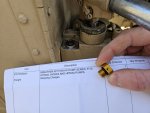aw113sgte
Well-known member
- 914
- 1,424
- 93
- Location
- La Crosse, WI
Got my vented pump cap. Removed all air lift and air/oil lines. Also took the safety valves out of the spare tire cylinder as I occasionally have it lock up.
Also checked out the manifold orifices and valves, all in great shape. All filter checked and clear as well.
Having an issue with overflowing the reservoir though I fill it up with the tire up and the cab down. I lift the cab up then let it go down and the reservoir overflows. I do it again and it overflows some more. I do it again and it overflows a third time. It is getting less each time but baffles me why it is at all. I can only figure there's some air in the system that's taking up room and causing the overflow? The other thing I noticed is when I let the cab lower due to gravity, I have to pump it probably 40 times before the cylinder is fully retracted. I could have sworn before it was just a few pumps for that to happen.
Also checked out the manifold orifices and valves, all in great shape. All filter checked and clear as well.
Having an issue with overflowing the reservoir though I fill it up with the tire up and the cab down. I lift the cab up then let it go down and the reservoir overflows. I do it again and it overflows some more. I do it again and it overflows a third time. It is getting less each time but baffles me why it is at all. I can only figure there's some air in the system that's taking up room and causing the overflow? The other thing I noticed is when I let the cab lower due to gravity, I have to pump it probably 40 times before the cylinder is fully retracted. I could have sworn before it was just a few pumps for that to happen.
Attachments
-
99.2 KB Views: 5



